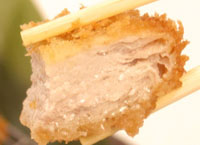|
|
|||||||
|
|
|||||||
|
|||||||
| | Web Japan >> | Trends in Japan >> | Lifestyle >> | Layered Food | |
|
LAYERED FOOD Fashion-Inspired Technique Creates New Tastes (December 8, 2005) The kasanegi (layered) look, featuring two or more layers of clothing, has become a staple of Japanese fashion in recent years, and now a culinary technique inspired by this fashion concept is gaining popularity. Described by many as kasanegi food, this technique involves arranging the same ingredient in multiple layers to create a unique texture and taste. "Layered food" has found favor among chefs in a range of different culinary fields. 25 Delicious Layers Whereas traditional tonkatsu involves frying a single cut of breaded pork until its is pleasingly firm and crunchy, Kimukatsu instead layers thinly sliced pork into a single cutlet. At Kimukatsu, this "layered" dish calls for slices of pork loin from Yamagata Prefecture to be cut to an extremely thin 0.5 mm or less, layered at least 25 slices thick, battered, and then fried. According to the company's web site, this method produces tonkatsu in which "nearly 80% of the fat melts away, leaving the juicy meat to meld with the crispy batter coating in a sensuous harmony." The end result is a cutlet lighter and leaner than its predecessors. Even women and seniors, who typically do not care for the large amounts of fat found in many tonkatsu, have given favorable reviews. Kimukatsu also offers layered cutlets seasoned with black pepper or garlic. Some people have nicknamed the dish mirukatsu ("mille-cutlet"), since the creation resembles the flaky layers of a mille-feuille pastry when cut in half. Origin Toshu Co., operator of a large boxed-lunch and delicatessen chain, has already put this description to use by offering layered-style tonkatsu in its Mirukatsu boxed lunch. Double the Flavor As a culinary technique, layering is hardly a recent innovation - the sandwich, for example, has been around for years. Cakes and other desserts with different layers of fruit and cream are also quite common. Dishes that involve layering assorted ingredients and then frying, grilling, or steaming are not limited to Japanese cuisine. Shops offering tonkatsu with such fillings as cheese or plum are not uncommon. And Domino's Pizza offers a popular mille-feuille pizza, with a ring of cheese baked into its crust. Clearly, layering an assortment of ingredients to create new tastes and textures is an age-old technique. What makes mirukatsu and layered sushi different, however, is the careful layering of a single ingredient to create a new and enjoyable eating experience. There are plenty of inventive chefs in Japan, so diners can expect to be tempted by more "layered food" innovations as this technique spreads. Copyright (c) 2005 Web Japan. Edited by Japan Echo Inc. based on domestic Japanese news sources. Articles presented here are offered for reference purposes and do not necessarily represent the policy or views of the Japanese Government. |
FAST-FOOD EXPORTS (October 13, 2005) | |
|




